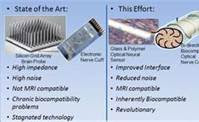Sound and audio can be sent to the auditory cortex of the subject's brain (bypassing the ears) and images can be sent into the visual cortex.
Dome allows for a complete audiovisual brain-to-computer link.
Neuronal activity in the brain creates a shifting electrical pattern that has a shifting magnetic flux. This magnetic flux puts out a constant 30-50 Hz 5 milliwatt electromagnetic (EMF) wave. Contained in the electromagnetic emission from the brain are patterns called "evoked potentials."
Every thought, reaction, motor command, auditory event, and visual image in the brain has a corresponding "evoked potential" or net of "evoked potentials". The EMF emission from the brain can be decoded into the current thoughts, images and sounds in the subject's brain.
Dome uses EMF-transmitted Brain Stimulators as a communications system to transmit information
The inserts Brain stimulation works by sending a completely coded and pulsed
electromagnetic signal to trigger evoked potentials (events) in the brain, thereby forming sound and visual images in the brains' neural circuits. EMF Brain Stimulation can also change a person's brain-states and affect motor control.
electromagnetic signal to trigger evoked potentials (events) in the brain, thereby forming sound and visual images in the brains' neural circuits. EMF Brain Stimulation can also change a person's brain-states and affect motor control.
Two-way electronic Brain-Link or Graphing is done by remotely monitoring neural
audiovisual information while transmitting sound to the auditory cortex
(bypassing the ears) and transmitting faint images to the visual cortex
(bypassing the optic nerves and eyes). The images appear as floating 2-D screens in the brain.
audiovisual information while transmitting sound to the auditory cortex
(bypassing the ears) and transmitting faint images to the visual cortex
(bypassing the optic nerves and eyes). The images appear as floating 2-D screens in the brain.
Dome requires decoding the resonance frequency of each specific brain area. That frequency is then modulated in order to impose information in that specific brain area. The frequency to which the various brain areas respond varies from 3 Hz. to 50 Hz.




No comments:
Post a Comment